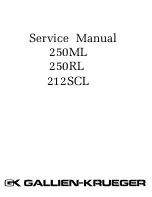
Talking to Individual System Modules
Talking to individual system modules within the HP 16500C Logic Analysis
System is done by preceding the module commands with the SELECT
command and the number of the slot in which the desired module is installed.
The mainframe is selected in the same way as an installed module by using
the SELECT 0 command.
Example
To select the module in slot 3 use the following:
OUTPUT XXX;":SELECT 3"
See Also
Chapter 10, "Mainframe Commands" for more information on the SELECT
command.
Initialization
To make sure the bus and all appropriate interfaces are in a known state,
begin every program with an initialization statement. BASIC provides a
CLEAR command that clears the interface buffer. If you are using HP-IB,
CLEAR will also reset the parser in the Logic Analysis System. The parser is
the program resident in the Logic Analysis System that reads the instructions
you send to it from the controller.
After clearing the interface, you could, for example, preset the logic analyzer
module to a known state by loading a predefined configuration file from the
disk.
Refer to your controller manual and programming language reference manual
for information on initializing the interface.
Introduction to Programming
Talking to Individual System Modules
1–4
Summary of Contents for 16501A LOGIC
Page 2: ...ii ...
Page 12: ...Contents 8 ...
Page 14: ......
Page 15: ...1 Introduction to Programming ...
Page 38: ...1 24 ...
Page 39: ...2 Programming Over HP IB ...
Page 45: ...3 Programming Over RS 232 C ...
Page 55: ...4 Programming Over LAN ...
Page 68: ...4 14 ...
Page 69: ...5 Programming and Documentation Conventions ...
Page 81: ...6 Message Communication and System Functions ...
Page 91: ...7 Status Reporting ...
Page 93: ...Figure 7 1 Status Byte Structures and Concepts Status Reporting 7 3 ...
Page 97: ...Figure 7 2 Service Request Enabling Status Reporting Key Features 7 7 ...
Page 100: ...Figure 7 3 Parallel Poll Data Structure Status Reporting Parallel Poll 7 10 ...
Page 105: ...8 Error Messages ...
Page 110: ...8 6 ...
Page 112: ......
Page 113: ...9 Common Commands ...
Page 116: ...Figure 9 1 Common Commands Syntax Diagram Common Commands 9 4 ...
Page 122: ...Figure 9 2 IST Data Structure Common Commands IST Individual Status 9 10 ...
Page 132: ...9 20 ...
Page 133: ...10 Mainframe Commands ...
Page 135: ...Figure 10 1 Mainframe Commands Syntax Diagram Mainframe Commands 10 3 ...
Page 136: ...Figure 10 1 continued Mainframe Commands Syntax Diagram continued Mainframe Commands 10 4 ...
Page 159: ...11 SYSTem Subsystem ...
Page 161: ...Figure 11 1 System Subsystem Commands Syntax Diagram SYSTem Subsystem 11 3 ...
Page 172: ...11 14 ...
Page 173: ...12 MMEMory Subsystem ...
Page 175: ...Figure 12 1 MMEMory Subsystem Commands Syntax Diagram MMEMory Subsystem 12 3 ...
Page 198: ...12 26 ...
Page 199: ...13 INTermodule Subsystem ...
Page 201: ...Figure 13 1 Intermodule Subsystem Commands Syntax Diagram INTermodule Subsystem 13 3 ...
Page 216: ...13 18 ...
Page 217: ...14 TGTctrl Subsystem ...
Page 219: ...Figure 14 1 Targetcontrol Subsystem Commands Syntax Diagram TGTctrl Subsystem 14 3 ...
Page 220: ...Figure 14 1 continued Targetcontrol Subsystem Commands Syntax Diagram TGTctrl Subsystem 14 4 ...
Page 233: ...Part 3 15 Programming Examples 15 1 Programming Examples ...
Page 234: ......
Page 235: ...15 Programming Examples ...
















































